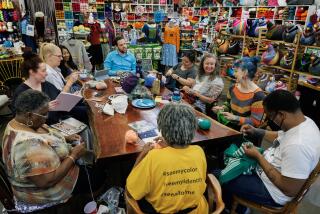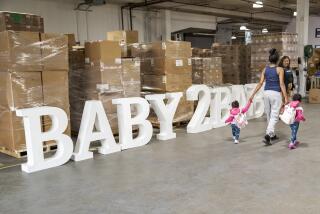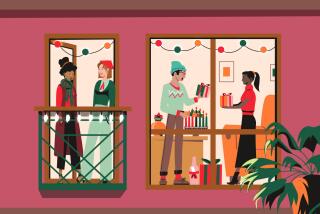What You Can Do With One Ball of Yarn : Charity: Knitters in the Caps for Kids project made 363,600 hats in 1992, warming heads--and hearts--of the needy.
It is a Sunday afternoon in January. Outside, dirty snowbanks and leaden skies create a dreary landscape. But inside the Creative Warehouse yarn shop in Needham, Mass., color and cheer abound as seven women sit around a table, knitting. They have come from nearby suburbs for one purpose: to make warm caps for needy children to wear on wintry days like this.
Needles click. Fingers fly. Conversation flows, with only occasional pauses as knitters count stitches or check tension. Gradually, as the afternoon wears on, balls of yarn grow smaller and hats take shape. Once the caps are finished and topped off with a yarn pom-pom, shop owner Elissa Lazdowsky will deliver them to local charities as part of a nationwide program called Caps for Kids.
Claire Henley of Wayland, Mass., explains her presence at this monthly session by saying, “I just felt I wanted to do something for someone else. We who have enough need to be reaching out to those who don’t.”
Another knitter, Linda Nolan of Needham, who is working on a royal blue hat, adds, “Knitting caps may seem like a small thing, because by yourself you don’t make much of a contribution. But together you can do a lot.”
Just how much knitters like these across the country are doing for needy children becomes evident as Bonnie Greene of Concord, Calif., explains the success of the nonprofit program she founded 10 years ago. As the owner of a knitting shop, Yarn Country, she wanted to find a way for customers to use yarn left over at the end of a project.
“I kept thinking, ‘What can you do with one ball of yarn?’ ” Greene recalls. “I realized that you can knit a cap for a child.” She put together a folder containing free patterns, then asked customers to knit a hat for underprivileged children.
Response grew quickly. Within six months, Greene had collected 500 caps. Word of the program spread. Now more than 300 shops across the United States participate, each giving anywhere from five caps to thousands to charities in their area. In 1992, the program generated 363,600 handmade caps nationwide. Some participants also make mittens, afghans, baby layettes, scarves, and sweaters.
Recently, Greene was in Dallas, accepting a President’s Award from the Hobby Industry of America for her contributions to poor children.
Two of Greene’s customers at Yarn Country each make more than 1,000 caps a year, using yarn donated by manufacturers. Last year one of them, Mary Tripp, crocheted 1,600 hats, bringing her total since 1988 to 7,200.
Tripp, who is retired, likes to crochet while she watches television. “I’m a fiend for football,” she says with a laugh.
She estimates that each cap takes between 45 minutes and an hour to make. What impels her to spend up to eight hours a day crocheting for children she doesn’t even know? “I’ve seen so many homeless people,” she explains. “And I’ve seen kids over a period of time who are cold and need clothes. Their faces light up when they get a cap. They say, ‘It’s mine! I’ve got something new!’ ”
Although most knitters are women, men also participate in the project. Even children and teen-agers get involved. At the Creative Warehouse, a clothesline strung across the room holds 36 caps knit by students and teachers at Brown Junior High School in Newton, Mass. And in New York, a teacher told Greene that the program is giving her student knitters empathy for fellow students who are homeless.
Last month, Lazdowsky delivered 50 hats to the New England Home for Little Wanderers, a charitable agency in Boston. Explaining the value of such a donation, June Grant Leonard, an executive assistant at the agency, says, “This is an item we always need, especially during the winter months. Some children lose their hats, so we find ourselves going through a number of them each season. We always greatly appreciate contributions of hats and mittens.”
As Lazdowsky sees it, that ongoing need, common to charitable groups everywhere, is enough to keep knitters busy all year. Looking around the table at the caps in progress on this wintry afternoon, she says simply, “I don’t think you can ever run out of heads.”
(For free patterns to make hats for children, send a self-addressed, stamped, business-size envelope to Caps for Kids, P.O. Box 6500, Concord, Calif. 94524.)






